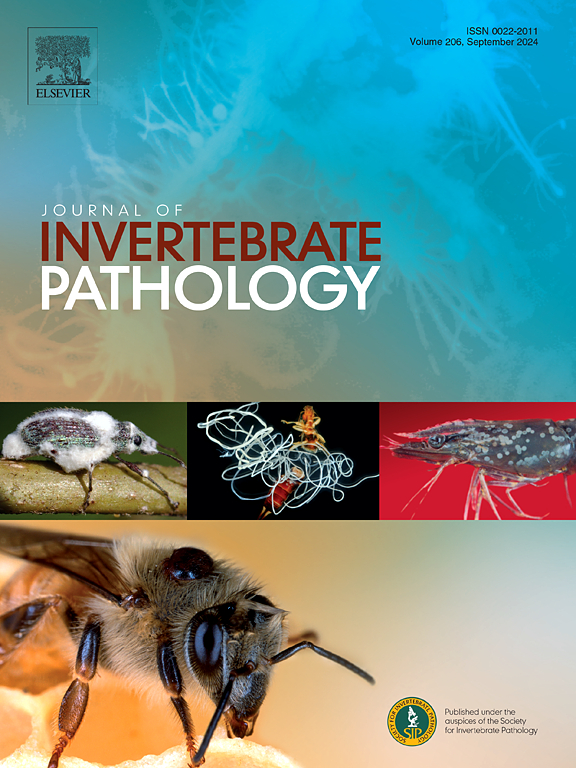Bacillus thuringiensis-derived pesticidal proteins toxic to the whitefly, Bemisia tabaci
IF 3.6
3区 生物学
Q1 ZOOLOGY
引用次数: 0
Abstract
The whitefly, Bemisia tabaci, is among the most important threats to global agriculture and food security. In addition to losses associated with feeding, B. tabaci vectors hundreds of plant viruses, many of which cause severe disease in staple food crops. The management of B. tabaci is confounded by extensive resistance to chemical insecticides. While pesticidal proteins derived from entomopathogenic bacteria such as Bacillus thuringiensis (Bt) could provide for alternative management approaches, only one pesticidal protein with toxicity to B. tabaci has been identified. Here we screened 11 Bt-derived pesticidal proteins from several different structural classes against the highly invasive, Middle East-Asian Minor 1 (MEAM1) cryptic species of B. tabaci, and assessed the impact of a B. tabaci-active protein on the gut epithelial membrane by transmission electron microscopy. The pesticidal proteins were expressed in Bt or in Escherichia coli and purified for use in bioassays. The toxicity of purified proteins was first assessed by feeding adults on a single dose followed by lethal concentration (LC50) determination for proteins with significant mortality relative to the buffer control. The proteins Tpp78Aa1, Tpp78Ba1, and Cry1Ca were toxic to B. tabaci with LC50 values of 99, 96, and 351 µg/mL, respectively. Disruption of the brush border and severe reduction in microvilli on the gut surface caused by Tpp78Aa1 is consistent with the mode of action of Bt-derived pesticidal proteins. These proteins may provide valuable tools for the integrated management of B. tabaci populations and associated reduced incidence of B. tabaci vectored plant viral diseases.

苏云金芽孢杆菌衍生的杀虫蛋白,对粉虱、烟粉虱有毒性。
白蝇,即烟粉虱,是对全球农业和粮食安全最重要的威胁之一。除了与取食有关的损失外,烟粉虱还传播数百种植物病毒,其中许多病毒会导致主食作物严重病害。烟粉虱对化学杀虫剂具有广泛的抗性,使其管理工作陷入混乱。虽然从苏云金芽孢杆菌(Bacillus thuringiensis, Bt)等昆虫致病细菌中提取的杀虫蛋白可以提供替代的管理方法,但目前只鉴定出一种对烟粉虱有毒性的杀虫蛋白。在这里,我们筛选了11种来自不同结构类别的bt衍生的杀虫蛋白,以对抗高侵袭性的MEAM1 (Middle - East-Asian Minor 1, MEAM1)烟粉虱隐种,并通过透射电镜评估了一种烟粉虱活性蛋白对肠道上皮膜的影响。这些杀虫蛋白在Bt或大肠杆菌中表达,纯化后用于生物测定。首先对纯化蛋白的毒性进行评估,先给成年鼠单次喂食,然后对相对于缓冲对照具有显著死亡率的蛋白进行致死浓度(LC50)测定。Tpp78Aa1、Tpp78Ba1和Cry1Ca蛋白对烟粉虱有毒性,LC50值分别为99、96和351 µg/mL。Tpp78Aa1引起的肠道刷状边界的破坏和肠道表面微绒毛的严重减少与bt衍生的杀虫蛋白的作用模式一致。这些蛋白可能为烟粉虱种群的综合管理和相关的降低烟粉虱病媒植物病毒病的发病率提供有价值的工具。
本文章由计算机程序翻译,如有差异,请以英文原文为准。
求助全文
约1分钟内获得全文
求助全文
来源期刊
CiteScore
6.10
自引率
5.90%
发文量
94
审稿时长
1 months
期刊介绍:
The Journal of Invertebrate Pathology presents original research articles and notes on the induction and pathogenesis of diseases of invertebrates, including the suppression of diseases in beneficial species, and the use of diseases in controlling undesirable species. In addition, the journal publishes the results of physiological, morphological, genetic, immunological and ecological studies as related to the etiologic agents of diseases of invertebrates.
The Journal of Invertebrate Pathology is the adopted journal of the Society for Invertebrate Pathology, and is available to SIP members at a special reduced price.

 求助内容:
求助内容: 应助结果提醒方式:
应助结果提醒方式:


